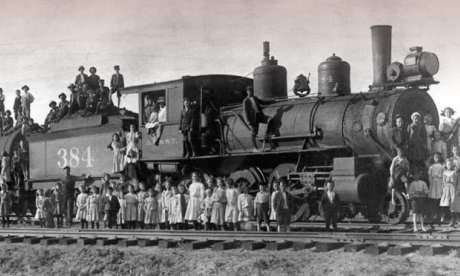Bizarre Belvidere: Belvidere and the Orphan Train

SUBMITTED PHOTO Belvidere Republican
Orphaned children pose with their train as it travels through rural Michigan.
As much as we might not like to think about it, orphans have always been a reality of our world. Among the many techniques our nation has hoped would bring some relief to its most unfortunate children were the “placing out programs,” starting in 1851.
“Placing out” referred to taking orphaned children, or children removed from “unqualified homes,” and placing them into rural homes. This differs from both older and modern fostering, where an orphaned child rarely leaves their home city.
The theory was that spending time on the city streets harmed children to an extent that they could never reintegrate into society without leaving those cities entirely. Many placed-out children remained fairly close to their home cities, usually not leaving the state, but many others travelled by train from town to town looking to for a home.
These “orphan trains,” sometimes-called baby trains or mercy trains, travelled quite far at times, even here to Belvidere. The New York Juvenile Asylum, now the Children’s Village, sent the most of any organization to Illinois specifically. Nearly all of the known orphan train children that came to Boone County were from The Asylum.
For many children, the promise of a kind farm family teaching them the value of work and self-discipline really did come true. The Asylum was required to submit annual reports of their progress as an organization. In those reports, they included letters of success cases, sent by children from the program. Some of those letters were from Belvidere children.
Anne Wander came to Belvidere in 1888 and wrote this in her letter to The Asylum in 1893, “I did not want to come West, and I cried and felt very bad about it, but now I thank God that I came, and I thank the Asylum a thousand times for sending me…My guardian is good and she does everything in her power for me…Miss Morris was my favorite teacher at The Asylum and she has written me twice since I have been here…I shall soon be able to make my own dresses…I have letters from my brother Charles, who has returned to New York.”
Her letter paints the picture of a child who was cared for both at the Asylum and at her home in Belvidere, a true success story.
Sadly, many other children did not see such success. Orphan train programs [generated] much controversy in their time. The most serious of which had to do with the legal status of the children themselves. They were not fosters in the modern sense; instead they were indentured to their guardian until they were adults.
While they could end the arrangement on their own terms, this was difficult due to how illiterate many of them were. For example, even among the success stories sent back to The Asylum, most were written by guardians and were only dictated by the children. Some were written directly by guardians, with no obvious input from the children at all. A written letter was one way to terminate their indenture, but how do you do that when you are illiterate?
Agents were supposed to visit in person to accommodate this problem, but they were spread so thinly that it could be a year or more between visits. Some children claimed that their agents never visited them even once.
Abolitionists sometimes even compared the program to slavery and it isn’t difficult to see why. Children were unloaded off their trains and essentially auctioned off in a line. Some participants even recalled having their muscles fondled and appraised like cattle as potential fosterers decided if they were fit to work.
If they weren’t chosen, they moved on to the next station and repeated the humiliating process. Most children were never formally adopted into their foster homes and acted entirely as indentured help. While it is true that biological farm children worked the land they were raised on for “no pay,” they typically received some form of inheritance, as small as it might be, and while abuse was not impossible for biological children, it was less likely than it was for indentured ones.
In theory, only caring, loving families were eligible to foster children; however families were rarely vetted because they were in small, rural communities. Local leaders were in charge of approving applicants, but denying a potential foster family meant telling the entire community they were unfit to raise children. As a result, candidates were rarely rejected even if they were obviously seeking free labor.
Criticisms of the orphan trains have been dismissed by some in the modern era as a necessity of a harder time. There is some truth to that, but it is also true that the program was contentious even at the time it operated.
Orphan trains ran from 1854-1929. During this time, the issue of slavery fueled civil war in 1861, the issue of fair labor resulted in a massacre at Homestead in 1892, and Illinois began passing child labor regulations in 1900. Times were different, and they were hard, but not so hard that people couldn’t question a flawed program.
Noah Lawyer’s account of his experience in Savannah, Missouri, highlights the program’s bizarre mix of hard necessities and clear shortcomings. He acknowledged that his life would have been far worse if he had stayed on the streets of New York, but he also lived out his entire childhood as “the help.” By his own recollection, he was never hugged, never told he was loved, never even given a Christmas gift. The orphan train gave him more than the street ever could but far less than he deserved.
The orphan letters that came out of Belvidere all praised the program, and no one from Belvidere ever made a serious public criticism related to their time as a foster. It is a hopeful thought that perhaps our humble community really did serve as an example for the program.
Unfortunately, the program as a whole did not have enough examples to outweigh their criticisms. In 1929, the orphan trains made their last stops and moved out of the way for the modern foster system to take over. This system has its own well documented flaws, some very similar to “placing out,” but it was a notable improvement for our community and others.


